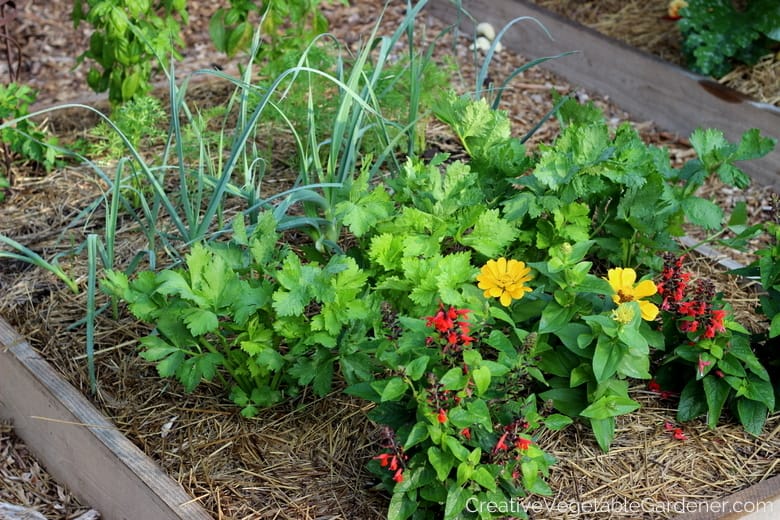
If you had to guess, what’s the most common mistake beginning gardeners make?
If you said, “starting with a garden that’s way too big”, you’re right!
Over the years I’ve met thousands of gardeners who get excited about the idea of growing their own food and then dig up a huge section of their yard.
Not the best idea!
It’s much easier to keep up with a small garden during the busy summer season. You’re more likely to be successful, which means you’re going to have a lot more fun.
And greater success will make you excited about continuing to garden the following season, and hopefully for many more seasons after that!
So, if you’re new to gardening, I encourage you to keep it simple and start small this season.
And if you’ve already hopped on the tiny garden bandwagon, here are my top tips on how to start a small vegetable garden and make the most of it so that it’s bursting with produce this year.
How to Make the Most of Your Small Vegetable Garden
Embrace a Small Footprint
Try not to be overly influenced by the many photos on social media romanticizing huge gardens and mini-farms. One thing that’s often not shared is how many hours it takes to maintain these large spaces.
I had a plot in a community garden for many years and the standard sized space was 20’ x 20’. After working in my own plot, I often took strolls around the garden to see what other people were growing.
Over time, I noticed that for many gardeners this size was often too big for them to keep up with. There were a lot of gardens that got overtaken by weeds and were suffering from neglect.
A more appropriate plot for beginning gardeners would have been about half that size, 10’x10’. That’s much more manageable for most busy folks.
And, surprisingly, you can actually grow a lot of food in a small plot like that if you garden efficiently.
If you’re thinking about building raised beds, starting with two or three will allow you to grow a handful of different vegetables and will also be easy to manage. A 4’ x 8’ raised bed is a common size, but you can build whatever size fits best in your garden space.
My garden is pretty large, especially for a city lot. At 1600 square feet I’m able to grow a lot of food for my husband and I. But, planting, weeding, watering, and harvesting from a garden of this size is a considerable commitment of time for many months of the year.
For me, it’s time I spend joyfully, and I have almost 20 years of gardening experience under my belt.
If you’re starting a small vegetable garden or considering downsizing to a smaller garden, you need to be honest with yourself about how much time you truly have to devote to your garden.
If you’re not sure how much you’ll like growing your own food, or you don’t have a sense of how much time is required, then I suggest starting small.
You can always expand your garden in the coming years after you’ve fallen in love with growing your own food.
If you have a plot in a community garden, I have some specific tips for making the most of that space, including the best vegetables to grow, in this post.
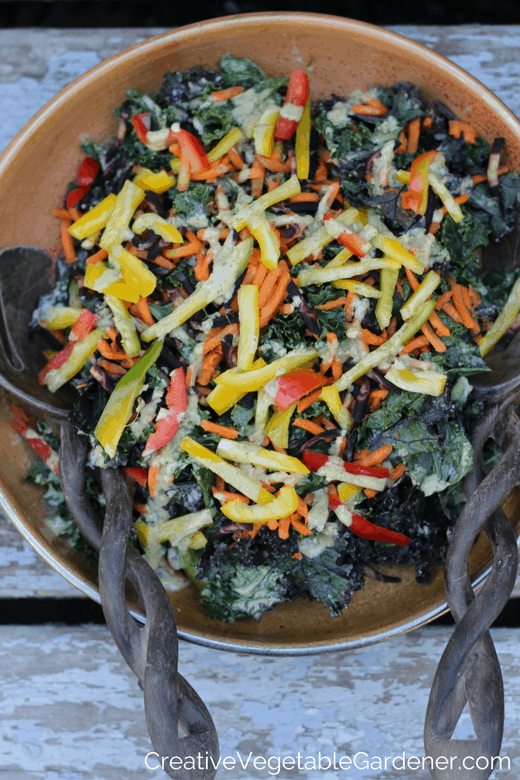
We eat a lot of kale in our house, so growing it is a top priority each season.
Be Strategic in What You Grow
When you’re tight on space, it’s even more important to plant and grow vegetables that will give you the biggest bang for your buck. But, what’s worth it to grow depends upon you – what you like to eat, what you buy on a regular basis, and which vegetables are on your priority list.
Here are two important things to take into consideration when you’re planning which vegetables to grow in your garden.
#1: Grow what you eat.
When starting a small vegetable garden, a critical first step is deciding what to grow. The best way to do this is to take a close look at your eating and grocery shopping habits.
What do you eat and buy from the grocery store on a regular basis?
What are your favorite weekly go-to meals?
Review your typical shopping list and deconstruct your favorite meal recipes to see if you can grow any of your household’s most popular vegetables in your garden.
It may sound obvious, but if you grow what you eat you’ll get much more satisfaction (and savings) from your garden. Focus on the five vegetables you eat the most and plan those into your garden first.
I have a special gift to help you through this strategic process. Delve deeper into what you want to grow this year with the help of several pages (with worksheets) from my book, Smart Start Garden Planner. Find them here: What Do You Want to Grow.
#2: Understand the different characteristics of each vegetable.
After taking a bigger view and thinking about what foods you eat and buy every week, your next step is to look critically at each vegetable and decide whether it’s “worth it” to grow in your garden.
This is especially important when you garden in a small space. You’ll want to choose vegetables that give you the biggest bang for your buck.
What’s worth it to grow is a somewhat personal decision for each of us. I grow lots of onions in my garden (500!) every season, but another gardener might think that’s a waste of space and prefer to buy inexpensive onions at the grocery store instead.
One way to think more strategically about each vegetable is to look at the different categories it falls into. In my book, Smart Start Garden Planner, I have an entire section devoted to this topic. It’s called Veggie Essentials: Getting to Know the Different Characteristics of Each Vegetable.
In it, I walk you through four different ways to look at vegetables. (I’ve linked to the blog posts I’ve written about two of them.)
- In what season you’ll get a harvest
- How much food you’ll harvest from each plant
- How big the plants grow
- How many days until the plant will produce food
It’s the complete picture of each vegetable, along with your eating, cooking, and grocery shopping preferences that will help you choose whether you want to grow it or not.
If you want to explore this topic more, check out my fun garden planning workbook, Smart Start Garden Planner. Find out more and download a sample of the book here.
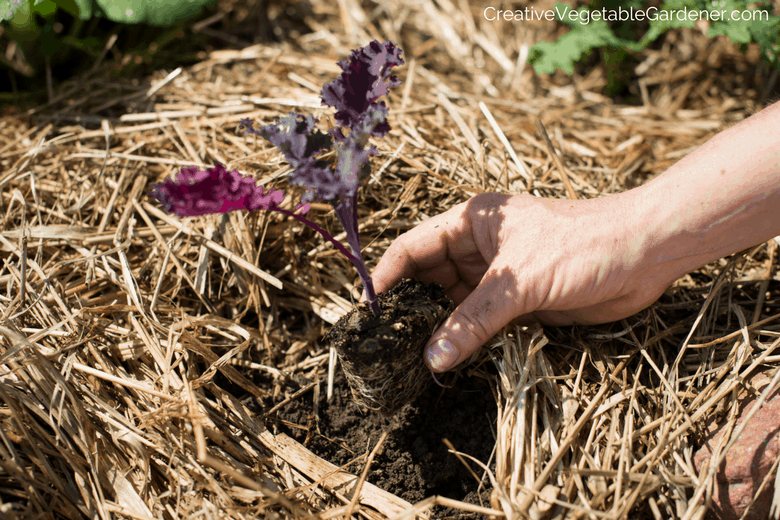
Start with Seedlings
There are different ways to plant vegetables in your garden. Some things are more commonly grown by starting with a seedling (a baby plant), and some vegetables are grown by planting a seed in the ground.
Seeds often need more attention initially than plants, since they need to be watered every day or so until they germinate.
When you have a small garden, you can’t take the risk that some of your seeds won’t germinate and leave you with empty spaces. You need to take full advantage of the space you have and make sure you’re growing food in every nook and cranny.
Buying seedlings is a great way to skip over the tricky germination period and move right on to a healthy and growing plant. Seedlings can also give you a jump start on the season, which is a bonus when you don’t have a lot of growing space.
If you’re not sure which vegetables are sown by seed and which are planted with a seedling, check out this post where I break it all down for you.
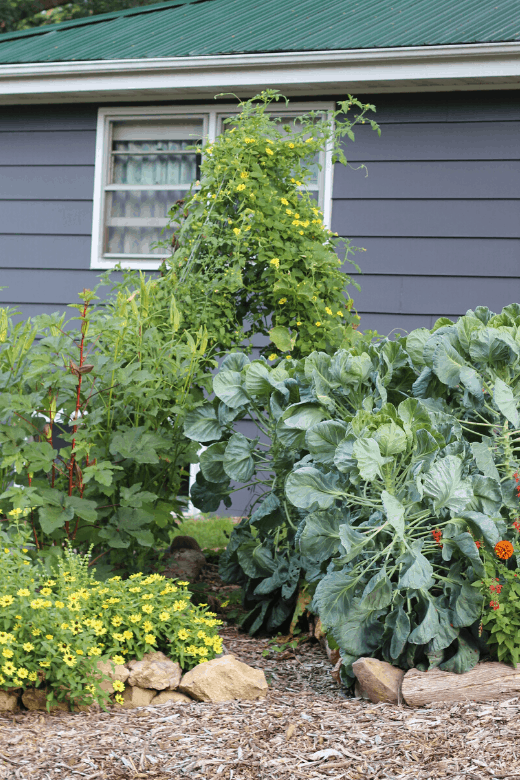
Grow up!
A great garden hack to add additional growing space in a small garden is to use trellises to grow vertically. This is also a wonderful way to add some architectural elements and visual interest to your garden.
There are some fabulously fun vegetables and flowers that thrive on vegetable trellises.
Some of my favorite vegetables to grow vertically in my garden are:
Cucumbers: Diva, Lemon, Boothby’s Blonde
Peas: Golden Sweet, Sugar Ann
Tomatoes: Sun Gold
Tomatillos: Purple and Green
Winter squash: Delicata, Butternut, Honey Nut
And I often mix flowers in with the above vegetables to add color and attract beneficial insects to my garden.
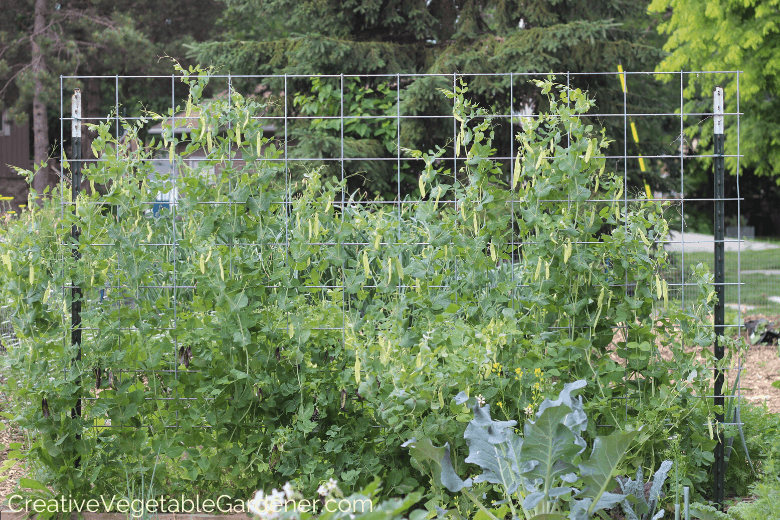
There are plenty of ready-made and DIY trellis designs to choose from.
Gardener’s Supply Company from Vermont is a reputable company that makes various trellis designs and sell them on Amazon. (This isn’t sponsored by them. I just wanted to give you some ideas!)
Keep in mind you can grow any vining plant on any of these trellises, not just the vegetable in the title.
Decorative Tower for Climbing Vegetables and Flowers
The two photos from my garden above feature different options for an incredibly simple DIY livestock panel trellis you can inexpensively create in a quick garden work session.
Read through the step by step directions for the vegetable trellis here.
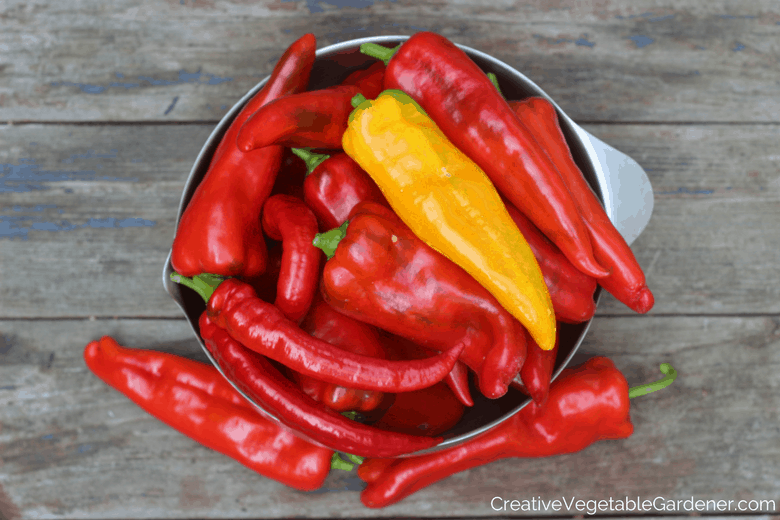
Red peppers are difficult to grow in Wisconsin, so I’ve asked my local farmers which varieties work well for them.
Buy Local
Each vegetable you grow in your garden comes in so many different varieties, shapes, colors and sizes that it can be confusing when you’re shopping for seedlings.
Which variety should you pick for your garden?
The best way to navigate this conundrum is to buy locally.
Don’t go to your local big-box store to shop for vegetable plants. It’s hard to know where they were grown and whether the variety performs well in your climate.
Instead, visit your local farmers market. At the market, my favorite people to by plants from are CSA farmers. They’re selling the exact varieties they’re growing in their own fields and are usually pretty picky about selecting high performing and delicious vegetables.
Plus, you can ask them about any variety you’re wondering about!
Don’t mess around with underperforming varieties in your garden. Make the extra effort to make sure the seeds and plants you’re selecting for your garden are right for your area.
You’ll end up with a much more successful harvest this way!
Read more about the top mistakes to avoid when buying seeds and plants here.
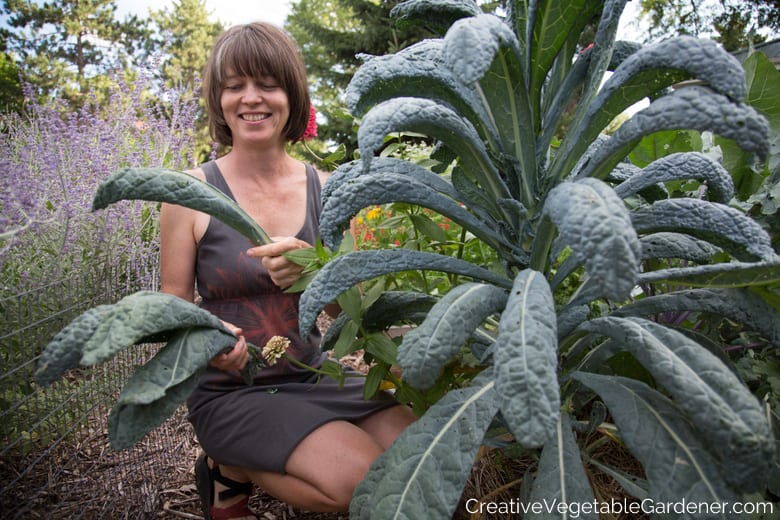
I love being in my garden on a summer evening, harvesting food for the week’s cooking!
Immerse Yourself in the Experience No Matter Your Garden Size
If you let it, gardening can become one of the most fulfilling and joyful parts of your life. There’s nothing quite like going out your back door to harvest a bowl of fresh vegetables for dinner!
Take time to enjoy the sights, sounds, colors, and details of your garden, no matter the size.
One of the ways I do this is to spend early summer mornings with my camera taking photos of the tiny details that catch my eye and creating colorful vignettes from my harvests. (I share many of those photos through Instagram.)
You could also set up a chair near your garden for resting and relaxing, drink your morning coffee on your back step while gazing at your garden, or set up some birdhouses to attract more wildlife to your yard, which you can watch from your window.
When you pause and take some time to immerse yourself in the pleasures of growing your own food, gardening starts to become less of a hobby and more of a daily lifestyle that can radically transform your health and your life.
Additional Resources
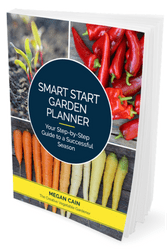
Practical, down-to-earth, and fun garden planning! After reading the Smart Start Garden Planner, you’ll have a personalized blueprint for what a successful season in your garden looks like. Plan your best season yet! Get your copy here.
Find my top recommended gardening books, tools, supplies, seeds and more in my Amazon storefront.
Just because your garden is small doesn’t mean you won’t get all of the wonderful benefits of gardening – abundant harvests for your dinner table, an intimate connection to the seasons, and exercise and time spent outside in nature.
As you go forward in your small garden planning, I encourage you to approach it with a strategic eye mixed with a sense of curiosity and adventure. This ensures you’ll always be having fun and learning!
And, starting small is a manageable and simple way to dip your toes (hands!) into the experience of growing your own food. If you love it as much as I think you will, you can always plot your garden expansion for the following spring!
.
Check out these posts for more tips on planning your garden.
- How Much Food Will You Get From Each Vegetable Plant?
- Free 10 Step Guide to Planning a Smart Spring Garden
- Unique & Colorful Varieties to Grow This Year
SHARE IT ON PINTEREST

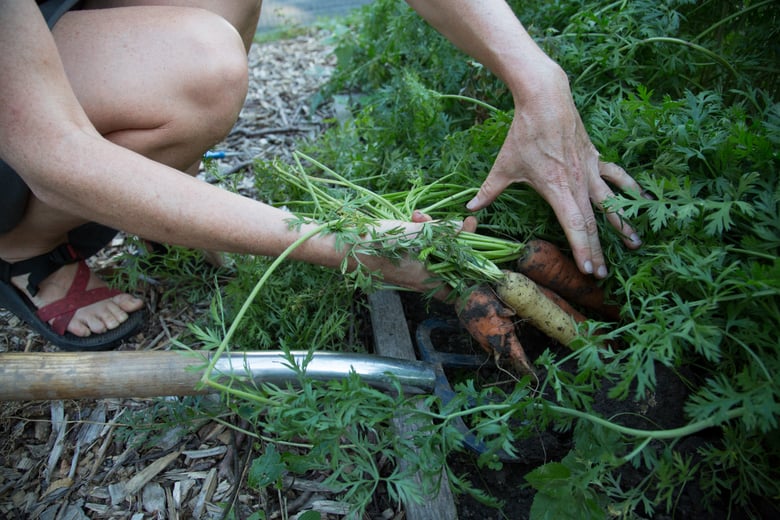




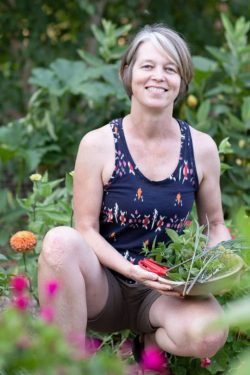

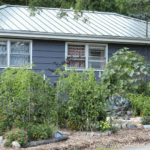
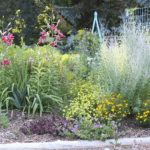
Comments
[…] How Do You Plan Your Small Garden? […]
[…] you have a small garden, or like many of us, you just can’t possibly fit everything you want to grow in your garden each […]
Need info on planting veg
Hi Maria- Can you explain more? What information are you looking for? My new garden planning book is packed full of information about the different vegetables.
[…] How Do You Plan Your Small Garden? […]
[…] How Do You Plan Your Small Garden? […]
[…] Tips for Planning a Small Vegetable Garden […]
Green vegetables is very helpful on health..Thanks for sharing this post..
My wife and I are wanting to start a garden this year, so thanks for sharing this. I like your point about buying seedlings to skip over the tricky germination period. We’ll have to look into this more so that we can speed up the process and make things easier for ourselves.